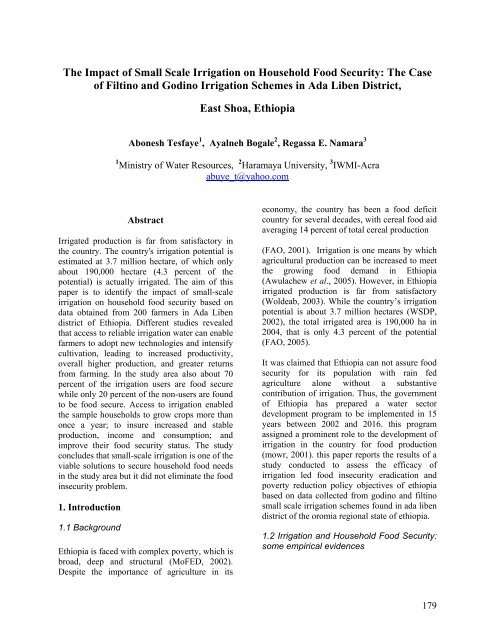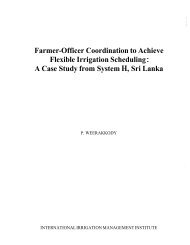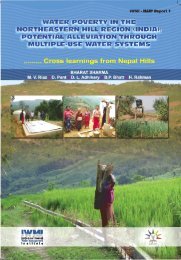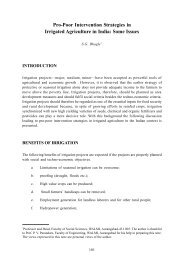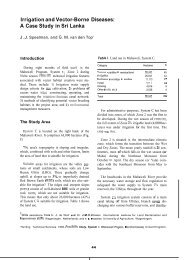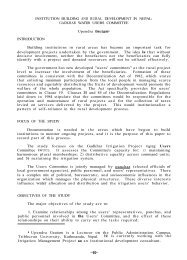The Impact of Small Scale Irrigation on Household Food Security ...
The Impact of Small Scale Irrigation on Household Food Security ...
The Impact of Small Scale Irrigation on Household Food Security ...
You also want an ePaper? Increase the reach of your titles
YUMPU automatically turns print PDFs into web optimized ePapers that Google loves.
<str<strong>on</strong>g>The</str<strong>on</strong>g> <str<strong>on</strong>g>Impact</str<strong>on</strong>g> <str<strong>on</strong>g>of</str<strong>on</strong>g> <str<strong>on</strong>g>Small</str<strong>on</strong>g> <str<strong>on</strong>g>Scale</str<strong>on</strong>g> <str<strong>on</strong>g>Irrigati<strong>on</strong></str<strong>on</strong>g> <strong>on</strong> <strong>Household</strong> <strong>Food</strong> <strong>Security</strong>: <str<strong>on</strong>g>The</str<strong>on</strong>g> Case<str<strong>on</strong>g>of</str<strong>on</strong>g> Filtino and Godino <str<strong>on</strong>g>Irrigati<strong>on</strong></str<strong>on</strong>g> Schemes in Ada Liben District,East Shoa, EthiopiaAb<strong>on</strong>esh Tesfaye 1 , Ayalneh Bogale 2 , Regassa E. Namara 31 Ministry <str<strong>on</strong>g>of</str<strong>on</strong>g> Water Resources, 2 Haramaya University, 3 IWMI-Acraabuye_t@yahoo.comAbstractIrrigated producti<strong>on</strong> is far from satisfactory inthe country. <str<strong>on</strong>g>The</str<strong>on</strong>g> country's irrigati<strong>on</strong> potential isestimated at 3.7 milli<strong>on</strong> hectare, <str<strong>on</strong>g>of</str<strong>on</strong>g> which <strong>on</strong>lyabout 190,000 hectare (4.3 percent <str<strong>on</strong>g>of</str<strong>on</strong>g> thepotential) is actually irrigated. <str<strong>on</strong>g>The</str<strong>on</strong>g> aim <str<strong>on</strong>g>of</str<strong>on</strong>g> thispaper is to identify the impact <str<strong>on</strong>g>of</str<strong>on</strong>g> small-scaleirrigati<strong>on</strong> <strong>on</strong> household food security based <strong>on</strong>data obtained from 200 farmers in Ada Libendistrict <str<strong>on</strong>g>of</str<strong>on</strong>g> Ethiopia. Different studies revealedthat access to reliable irrigati<strong>on</strong> water can enablefarmers to adopt new technologies and intensifycultivati<strong>on</strong>, leading to increased productivity,overall higher producti<strong>on</strong>, and greater returnsfrom farming. In the study area also about 70percent <str<strong>on</strong>g>of</str<strong>on</strong>g> the irrigati<strong>on</strong> users are food securewhile <strong>on</strong>ly 20 percent <str<strong>on</strong>g>of</str<strong>on</strong>g> the n<strong>on</strong>-users are foundto be food secure. Access to irrigati<strong>on</strong> enabledthe sample households to grow crops more than<strong>on</strong>ce a year; to insure increased and stableproducti<strong>on</strong>, income and c<strong>on</strong>sumpti<strong>on</strong>; andimprove their food security status. <str<strong>on</strong>g>The</str<strong>on</strong>g> studyc<strong>on</strong>cludes that small-scale irrigati<strong>on</strong> is <strong>on</strong>e <str<strong>on</strong>g>of</str<strong>on</strong>g> theviable soluti<strong>on</strong>s to secure household food needsin the study area but it did not eliminate the foodinsecurity problem.1. Introducti<strong>on</strong>1.1 BackgroundEthiopia is faced with complex poverty, which isbroad, deep and structural (MoFED, 2002).Despite the importance <str<strong>on</strong>g>of</str<strong>on</strong>g> agriculture in itsec<strong>on</strong>omy, the country has been a food deficitcountry for several decades, with cereal food aidaveraging 14 percent <str<strong>on</strong>g>of</str<strong>on</strong>g> total cereal producti<strong>on</strong>(FAO, 2001). <str<strong>on</strong>g>Irrigati<strong>on</strong></str<strong>on</strong>g> is <strong>on</strong>e means by whichagricultural producti<strong>on</strong> can be increased to meetthe growing food demand in Ethiopia(Awulachew et al., 2005). However, in Ethiopiairrigated producti<strong>on</strong> is far from satisfactory(Woldeab, 2003). While the country’s irrigati<strong>on</strong>potential is about 3.7 milli<strong>on</strong> hectares (WSDP,2002), the total irrigated area is 190,000 ha in2004, that is <strong>on</strong>ly 4.3 percent <str<strong>on</strong>g>of</str<strong>on</strong>g> the potential(FAO, 2005).It was claimed that Ethiopia can not assure foodsecurity for its populati<strong>on</strong> with rain fedagriculture al<strong>on</strong>e without a substantivec<strong>on</strong>tributi<strong>on</strong> <str<strong>on</strong>g>of</str<strong>on</strong>g> irrigati<strong>on</strong>. Thus, the government<str<strong>on</strong>g>of</str<strong>on</strong>g> Ethiopia has prepared a water sectordevelopment program to be implemented in 15years between 2002 and 2016. this programassigned a prominent role to the development <str<strong>on</strong>g>of</str<strong>on</strong>g>irrigati<strong>on</strong> in the country for food producti<strong>on</strong>(mowr, 2001). this paper reports the results <str<strong>on</strong>g>of</str<strong>on</strong>g> astudy c<strong>on</strong>ducted to assess the efficacy <str<strong>on</strong>g>of</str<strong>on</strong>g>irrigati<strong>on</strong> led food insecurity eradicati<strong>on</strong> andpoverty reducti<strong>on</strong> policy objectives <str<strong>on</strong>g>of</str<strong>on</strong>g> ethiopiabased <strong>on</strong> data collected from godino and filtinosmall scale irrigati<strong>on</strong> schemes found in ada libendistrict <str<strong>on</strong>g>of</str<strong>on</strong>g> the oromia regi<strong>on</strong>al state <str<strong>on</strong>g>of</str<strong>on</strong>g> ethiopia.1.2 <str<strong>on</strong>g>Irrigati<strong>on</strong></str<strong>on</strong>g> and <strong>Household</strong> <strong>Food</strong> <strong>Security</strong>:some empirical evidences179
Chamber (1994) based <strong>on</strong> some empiricalstudies c<strong>on</strong>firms that reliable and adequateirrigati<strong>on</strong> increases employment, i.e., Landlesslaborers as well as small and marginal farmershave more work <strong>on</strong> more days<str<strong>on</strong>g>of</str<strong>on</strong>g> the year, which ultimately c<strong>on</strong>tributes to foodsecurity. A study c<strong>on</strong>ducted in 10 Indian villagesin different agro-climatic regi<strong>on</strong>s shows thatincreasing irrigati<strong>on</strong> by 40 percent was equallyeffective in reducing poverty (reducing foodinsecurity) as providing a pair <str<strong>on</strong>g>of</str<strong>on</strong>g> bullocks,increasing educati<strong>on</strong>al level and increasing wagerates (Singh et al., 1996). Kumar (2003) alsostated that irrigati<strong>on</strong> has significantlyc<strong>on</strong>tributed to boosting India's food producti<strong>on</strong>and creating grain surpluses used as droughtbuffer. A study by Hussain et al. (2004)c<strong>on</strong>firms that access to reliable irrigati<strong>on</strong> watercan enable farmers to adopt new technologiesand intensify cultivati<strong>on</strong>, leading to increasedproductivity, overall higher producti<strong>on</strong>, andgreater returns from farming. This in turn opensup new employment opportunities; both <strong>on</strong> farmand <str<strong>on</strong>g>of</str<strong>on</strong>g>f-farm, and can improve incomes,livelihood, and the quality <str<strong>on</strong>g>of</str<strong>on</strong>g> life in rural areas.<str<strong>on</strong>g>The</str<strong>on</strong>g> same study identified five key dimensi<strong>on</strong>s<str<strong>on</strong>g>of</str<strong>on</strong>g> how access to good irrigati<strong>on</strong> waterc<strong>on</strong>tributes to socioec<strong>on</strong>omic uplift <str<strong>on</strong>g>of</str<strong>on</strong>g> ruralcommunities. <str<strong>on</strong>g>The</str<strong>on</strong>g>se are producti<strong>on</strong>, income andc<strong>on</strong>sumpti<strong>on</strong>, employment, food security, andother social impacts c<strong>on</strong>tributing to overallimproved welfare.According to a study carried out <strong>on</strong> fiveirrigati<strong>on</strong> schemes in Zimbabwe, the schemeswere found to act as sources <str<strong>on</strong>g>of</str<strong>on</strong>g> food security forthe participants and the surrounding communitythrough increased productivity, stableproducti<strong>on</strong> and incomes (Mudima, 1998). <str<strong>on</strong>g>The</str<strong>on</strong>g>same study reported that farmers participating inirrigati<strong>on</strong> schemes never run out <str<strong>on</strong>g>of</str<strong>on</strong>g> food unliketheir counterparts that depend <strong>on</strong> rain-fedagriculture.Ngigi (2002) disclosed that in Kenya for the twodecades agricultural producti<strong>on</strong> has not beenable to keep pace with the increasing populati<strong>on</strong>.To address this challenge the biggest potentialfor increasing agricultural producti<strong>on</strong> lies in thedevelopment <str<strong>on</strong>g>of</str<strong>on</strong>g> irrigati<strong>on</strong>. According to thesame study, irrigati<strong>on</strong> can assist in agriculturaldiversificati<strong>on</strong>, enhance food self sufficiency,increase rural incomes, generate foreignexchange and provide employment opportunitywhen and where water is a c<strong>on</strong>straint. Nigigic<strong>on</strong>cluded that the major c<strong>on</strong>tributi<strong>on</strong>s <str<strong>on</strong>g>of</str<strong>on</strong>g>irrigati<strong>on</strong> to the nati<strong>on</strong>al ec<strong>on</strong>omy are foodsecurity, employment creati<strong>on</strong>, and improvedforeign exchange earning.A study by IFAD (2005) states that in Ethiopia,the c<strong>on</strong>structi<strong>on</strong> <str<strong>on</strong>g>of</str<strong>on</strong>g> small-scale irrigati<strong>on</strong>schemes has resulted in increased producti<strong>on</strong>,income and diet diversificati<strong>on</strong> in the Oromiaand Southern Nati<strong>on</strong> and Nati<strong>on</strong>alities People(SNNP) regi<strong>on</strong>s. According to this study, thecash generated from selling vegetables and otherproduce is comm<strong>on</strong>ly used to buy food to coverthe household food demand during the fooddeficit m<strong>on</strong>ths. <str<strong>on</strong>g>The</str<strong>on</strong>g> same study further addedthat during an interview c<strong>on</strong>ducted with somefarmers, it was disclosed that the hungry m<strong>on</strong>thsreduced from 6 to 2 m<strong>on</strong>ths (July and August)because <str<strong>on</strong>g>of</str<strong>on</strong>g> the use <str<strong>on</strong>g>of</str<strong>on</strong>g> small scale irrigati<strong>on</strong>.Moreover, the increase in diversity <str<strong>on</strong>g>of</str<strong>on</strong>g> cropsacross the schemes and the shift from cereallivestocksystem to cereal-vegetable-livestocksystem is starting to improve the diversity <str<strong>on</strong>g>of</str<strong>on</strong>g>household nutriti<strong>on</strong> through making vegetablespart <str<strong>on</strong>g>of</str<strong>on</strong>g> the daily diet. A study c<strong>on</strong>ducted byWoldeab (2003) also identified that in Tigrayregi<strong>on</strong> irrigated agriculture has benefited somehouseholds by providing an opportunity toincrease agricultural producti<strong>on</strong> through doublecropping and by taking advantage <str<strong>on</strong>g>of</str<strong>on</strong>g> moderntechnologies and high yielding crops that calledfor intensive farming.However, these studies were descriptive thananalytical in that they did not formally accountfor/ isolate the possible c<strong>on</strong>tributi<strong>on</strong> <str<strong>on</strong>g>of</str<strong>on</strong>g> otherc<strong>on</strong>founding variables such hashousehold/village characteristics, and otherpolicies and interventi<strong>on</strong>s that might have aswell c<strong>on</strong>tributed to the food security statusdifferences between irrigators and n<strong>on</strong>-irrigators.Moreover, the empirical works in this area arevery scant in Ethiopia in particular and in Africain general. Thus, the study aims to c<strong>on</strong>tribute tothe small scale irrigati<strong>on</strong>-food security literatureand to provide policy c<strong>on</strong>clusi<strong>on</strong>s and180
implicati<strong>on</strong>s for future planning <str<strong>on</strong>g>of</str<strong>on</strong>g> irrigati<strong>on</strong>systems.2. Research methodology2.1. Study area, sample size and samplingtechniquesgodino and filtino small scale irrigati<strong>on</strong> schemesare found in ada liben district and werec<strong>on</strong>structed by oromiya irrigati<strong>on</strong> developmentauthority (oida) in 1996 and 1998, respectively(oida, 2000 ). the water source for godinoirrigati<strong>on</strong> scheme is wedecha dam, which has thecapacity to irrigate about 310 ha. while the watersource for filtino irrigati<strong>on</strong> scheme is belbeladam, which has a capacity <str<strong>on</strong>g>of</str<strong>on</strong>g> irrigating 100 ha.the irrigable land in the respective commandareas is distributed to farmers by thegovernment. except few farmers who lease-inadditi<strong>on</strong>al irrigable land almost all farmers in thearea own quarter <str<strong>on</strong>g>of</str<strong>on</strong>g> a hectare. the major types <str<strong>on</strong>g>of</str<strong>on</strong>g>crops grown by irrigati<strong>on</strong> are <strong>on</strong>i<strong>on</strong>, tomato,potato and chick pea am<strong>on</strong>g others.Out <str<strong>on</strong>g>of</str<strong>on</strong>g> the 45 Peasant Associati<strong>on</strong>s (PA) that arefound in the Ada Liben district, two PAs namelyGodino and Quftu were purposely selectedmainly because <str<strong>on</strong>g>of</str<strong>on</strong>g> availability <str<strong>on</strong>g>of</str<strong>on</strong>g> irrigati<strong>on</strong>schemes. To select sample resp<strong>on</strong>dents from thetwo PAs, first the household heads in the twoPAs were identified and stratified in to twostrata: irrigati<strong>on</strong> users and n<strong>on</strong>-users. <str<strong>on</strong>g>The</str<strong>on</strong>g>n thesample resp<strong>on</strong>dents from each stratum wereselected randomly using simple randomsampling technique. Since the number <str<strong>on</strong>g>of</str<strong>on</strong>g>household heads in the two groups wasproporti<strong>on</strong>al, equal number <str<strong>on</strong>g>of</str<strong>on</strong>g> sample is drawnfrom each group, i.e., 100 household heads wereselected from each group. In total 200household heads were interviewed.2.2. Data collecti<strong>on</strong><str<strong>on</strong>g>The</str<strong>on</strong>g> data required for this study was collectedfrom sample resp<strong>on</strong>dents using a semi-structuredquesti<strong>on</strong>naire. <str<strong>on</strong>g>The</str<strong>on</strong>g> enumerators for the datacollecti<strong>on</strong> were selected <strong>on</strong> the basis <str<strong>on</strong>g>of</str<strong>on</strong>g> theireducati<strong>on</strong>al background and their ability <str<strong>on</strong>g>of</str<strong>on</strong>g> thelocal language. One week training was given tothe enumerators about method <str<strong>on</strong>g>of</str<strong>on</strong>g> data collecti<strong>on</strong>and the c<strong>on</strong>tents <str<strong>on</strong>g>of</str<strong>on</strong>g> the questi<strong>on</strong>naire. Datacollecti<strong>on</strong> proper was started after pretest wasc<strong>on</strong>ducted and modificati<strong>on</strong>s were made based<strong>on</strong> the feedback from the pretest. Sec<strong>on</strong>daryinformati<strong>on</strong> that could supplement the primarydata was collected from published andunpublished documents obtained from differentgovernmental and n<strong>on</strong>-governmentalorganizati<strong>on</strong>s.2.3. Method <str<strong>on</strong>g>of</str<strong>on</strong>g> data analysis<str<strong>on</strong>g>The</str<strong>on</strong>g> study employed both descriptive andec<strong>on</strong>ometric techniques. <str<strong>on</strong>g>The</str<strong>on</strong>g> descriptive analysiswas performed using frequencies, means, andmaximum and minimum values. <str<strong>on</strong>g>The</str<strong>on</strong>g>ec<strong>on</strong>ometric analysis employed the Heckmantwo-step procedure to identify the impact <str<strong>on</strong>g>of</str<strong>on</strong>g>small scale irrigati<strong>on</strong> <strong>on</strong> household food securityfrom am<strong>on</strong>g possible other household foodsecurity influencing factors.Heckman two-step procedure: Evaluating theimpact <str<strong>on</strong>g>of</str<strong>on</strong>g> a project/program <strong>on</strong> an outcomevariable using regressi<strong>on</strong> analysis can lead tobiased estimate if the underlying process whichgoverns selecti<strong>on</strong> into a project/ program is notincorporated in the empirical framework. <str<strong>on</strong>g>The</str<strong>on</strong>g>reas<strong>on</strong> for this is that, the effect <str<strong>on</strong>g>of</str<strong>on</strong>g> the programmay be over (under) estimated if programparticipants are more (less) able due to certainunobservable characteristics, to derive thesebenefits compared to eligible n<strong>on</strong>-participants(Zaman, 2001).To evaluate the impact <str<strong>on</strong>g>of</str<strong>on</strong>g> a program, a modelcomm<strong>on</strong>ly employed can be expressed as:Y = Xβ + αI+ u(1)Where Y is the outcome/impact, X is a vector <str<strong>on</strong>g>of</str<strong>on</strong>g>pers<strong>on</strong>al exogenous characteristics and I is adummy variable (I=1, if the individualparticipates in the program and 0 otherwise).From this model, the effect <str<strong>on</strong>g>of</str<strong>on</strong>g> the program ismeasured by the estimate <str<strong>on</strong>g>of</str<strong>on</strong>g> α . However, thedummy variable ‘I’ can not be treated asexogenous if the likelihood <str<strong>on</strong>g>of</str<strong>on</strong>g> an individual toparticipate or not to participate in the program is181
ased <strong>on</strong> an unobserved selecti<strong>on</strong> process(Maddala, 1983). Some studies have shown thelimitati<strong>on</strong>s <str<strong>on</strong>g>of</str<strong>on</strong>g> applying the classical linearregressi<strong>on</strong> methodology to the analysis <str<strong>on</strong>g>of</str<strong>on</strong>g>samples with selectivity bias (Heckman, 1979,Dardis et al. 1994, Sigelman and Zeng, 1999,Maddala, 1992). Applicati<strong>on</strong> <str<strong>on</strong>g>of</str<strong>on</strong>g> the classicallinear regressi<strong>on</strong> model does not guaranteec<strong>on</strong>sistent and unbiased estimates <str<strong>on</strong>g>of</str<strong>on</strong>g> theparameter. One soluti<strong>on</strong> to this problem inec<strong>on</strong>ometrics is the applicati<strong>on</strong> <str<strong>on</strong>g>of</str<strong>on</strong>g> Heckmantwo-step procedures. It is c<strong>on</strong>sidered as anappropriate tool to test and c<strong>on</strong>trol for sampleselecti<strong>on</strong> biases (Wooldrige, 2002).<str<strong>on</strong>g>The</str<strong>on</strong>g> Heckman two step procedures involves twoequati<strong>on</strong>s. <str<strong>on</strong>g>The</str<strong>on</strong>g> first equati<strong>on</strong> (i.e., the selecti<strong>on</strong>or participati<strong>on</strong> equati<strong>on</strong>) attempts to capture thefactors governing membership in a program.This equati<strong>on</strong> is used to c<strong>on</strong>struct a selectivityterm known as the ‘Mills ratio’ which isincluded as independent variable to the sec<strong>on</strong>dequati<strong>on</strong> known as resp<strong>on</strong>se or outcomeequati<strong>on</strong>. If the coefficient <str<strong>on</strong>g>of</str<strong>on</strong>g> the ‘selectivity’term is significant then the hypothesis that theparticipati<strong>on</strong> equati<strong>on</strong> is governed by anunobserved selecti<strong>on</strong> process or selectivity biasis c<strong>on</strong>firmed. Moreover, with the inclusi<strong>on</strong> <str<strong>on</strong>g>of</str<strong>on</strong>g>extra term, the coefficient in the sec<strong>on</strong>d stage‘selectivity corrected’ equati<strong>on</strong> is unbiased(Zaman, 2001). <str<strong>on</strong>g>The</str<strong>on</strong>g>refore, to evaluate theimpact <str<strong>on</strong>g>of</str<strong>on</strong>g> small scale irrigati<strong>on</strong> <strong>on</strong> householdfood security, we use the Heckman two-stepprocedure.Specificati<strong>on</strong> <str<strong>on</strong>g>of</str<strong>on</strong>g> the Heckman two-stepprocedure:Let Zikbe a group <str<strong>on</strong>g>of</str<strong>on</strong>g> K variables whichrepresent the characteristics <str<strong>on</strong>g>of</str<strong>on</strong>g> a household iwhich influences the probability <str<strong>on</strong>g>of</str<strong>on</strong>g> participati<strong>on</strong>in irrigati<strong>on</strong> agriculture measured by a latent*variable Diandγ kare the coefficients whichreflect the effect <str<strong>on</strong>g>of</str<strong>on</strong>g> these variables <strong>on</strong> theprobability <str<strong>on</strong>g>of</str<strong>on</strong>g> being an irrigati<strong>on</strong> farmer, andXisis a group <str<strong>on</strong>g>of</str<strong>on</strong>g> variables which represent thecharacteristics <str<strong>on</strong>g>of</str<strong>on</strong>g> household i which determinehousehold’s food security ( Ci) and β sare thecoefficients which reflect the effect <str<strong>on</strong>g>of</str<strong>on</strong>g> thesevariables <strong>on</strong> household food security. Thus, theHeckman two-step procedure takes thefollowing form:K*Di= ∑ γkZik+ ui(2)CiSS =1Ks= 1= ∑ β X + ε Observed <strong>on</strong>ly ifisiD * i>0...(3)Where the disturbances u iand εifollow abivariate normal distributi<strong>on</strong> with a zero mean,variance σuand σεrespectively, andcovarianceσ εu. <str<strong>on</strong>g>The</str<strong>on</strong>g>refore, we define adichotomous variable Diwhich takes a value 1when a household is an irrigator and 0otherwise. <str<strong>on</strong>g>The</str<strong>on</strong>g> estimator is based <strong>on</strong> thec<strong>on</strong>diti<strong>on</strong>al expectati<strong>on</strong> <str<strong>on</strong>g>of</str<strong>on</strong>g> the observed variable,household food security (C i) :E*( C / D > 0) = xβ+ σ σ λ( − γz)iiεuε(4)Where λ is the inverse Mills ratio defined asλ( − γZ) = φ( − γZ)/( 1−ϕ( − γZ)); β and γ arethe vectors <str<strong>on</strong>g>of</str<strong>on</strong>g> parameters which measure theeffect <str<strong>on</strong>g>of</str<strong>on</strong>g> variables X and Z, φ and ϕ are thefuncti<strong>on</strong>s <str<strong>on</strong>g>of</str<strong>on</strong>g> density and distributi<strong>on</strong> <str<strong>on</strong>g>of</str<strong>on</strong>g> a normal,respectively. <str<strong>on</strong>g>The</str<strong>on</strong>g> expressi<strong>on</strong> <str<strong>on</strong>g>of</str<strong>on</strong>g> c<strong>on</strong>diti<strong>on</strong>alexpectati<strong>on</strong> shows thatC iequals xβ<strong>on</strong>ly whenthe errors εiand uiare n<strong>on</strong> correlated, i.e.,σεu= 0 ; otherwise, the expectati<strong>on</strong> <str<strong>on</strong>g>of</str<strong>on</strong>g> Ciisaffected by the variable <str<strong>on</strong>g>of</str<strong>on</strong>g> equati<strong>on</strong> 2. Thus,from expressi<strong>on</strong> 4 we find that:*(i/ Di> 0) + Vi= xβ+ σu εσελ( − Z) ViCi/ Di> 0=EC/ γ + (5)WhereViis the distributed error term,( 0 , σ ( 1−σ( λ( λ − ))))NuγZε3. Results and discussi<strong>on</strong>3.1. Descriptive Resultsε182
<str<strong>on</strong>g>The</str<strong>on</strong>g> variables included in the model are definedin table 1. <str<strong>on</strong>g>The</str<strong>on</strong>g> dependent variable for the firststage <str<strong>on</strong>g>of</str<strong>on</strong>g> the Heckman two-step procedure isparticipati<strong>on</strong> in irrigati<strong>on</strong>. This variable is adummy variable (given a value <str<strong>on</strong>g>of</str<strong>on</strong>g> 1 if thehousehold participates in the irrigati<strong>on</strong> schemeand 0 otherwise) for the sec<strong>on</strong>d stage <str<strong>on</strong>g>of</str<strong>on</strong>g> themodel household food security status is ac<strong>on</strong>tinuous variable measured by the annualfood expenditure in Birr <str<strong>on</strong>g>of</str<strong>on</strong>g> the household peradult equivalent. Before discussing theec<strong>on</strong>ometric results, however, we present someinteresting descriptive results.One <str<strong>on</strong>g>of</str<strong>on</strong>g> the pervasive features <str<strong>on</strong>g>of</str<strong>on</strong>g> food insecurityin Ethiopia is that it is usually seas<strong>on</strong>al. Itmainly coincides with the active agriculturalseas<strong>on</strong> or wet seas<strong>on</strong>. To this effect we havetried to see if there is discernable difference inthe timing <str<strong>on</strong>g>of</str<strong>on</strong>g> food inadequacy between irrigatorsand n<strong>on</strong>-irrigators. Surprisingly, there is nodifference regarding the timing <str<strong>on</strong>g>of</str<strong>on</strong>g> foodshortages between irrigators and n<strong>on</strong>-irrigators(See Figure 1). <str<strong>on</strong>g>The</str<strong>on</strong>g> food shortage m<strong>on</strong>ths startas early as June (which is the beginning rainyseas<strong>on</strong> and therefore agricultural activities inthe study areas) and extends up to November(which is the beginning <str<strong>on</strong>g>of</str<strong>on</strong>g> harvest seas<strong>on</strong>). Nohousehold from the irrigators group has reportedfood shortage in June. September is the mostserious food shortage m<strong>on</strong>th am<strong>on</strong>g n<strong>on</strong>irrigators,while October is the peak foodshortage m<strong>on</strong>th for irrigators. About half <str<strong>on</strong>g>of</str<strong>on</strong>g> then<strong>on</strong>-irrigators reported food shortage in them<strong>on</strong>th <str<strong>on</strong>g>of</str<strong>on</strong>g> September. However, there is a starkdifference regarding the incidence rate <str<strong>on</strong>g>of</str<strong>on</strong>g>reported food shortage between the two groups.<str<strong>on</strong>g>The</str<strong>on</strong>g> proporti<strong>on</strong> <str<strong>on</strong>g>of</str<strong>on</strong>g> farmers reporting foodshortage in every m<strong>on</strong>th is significantly lowerfor irrigators group. It is interesting to note thatirrigati<strong>on</strong> has not eradicated the food insecurityproblem even in this seemingly better <str<strong>on</strong>g>of</str<strong>on</strong>g>f part <str<strong>on</strong>g>of</str<strong>on</strong>g>the country indicating the depth <str<strong>on</strong>g>of</str<strong>on</strong>g> the problem.% <str<strong>on</strong>g>of</str<strong>on</strong>g> households reporting food shortage6050403020100JuneJulyAugustSeptemberOctoberNovemberM<strong>on</strong>ths <str<strong>on</strong>g>of</str<strong>on</strong>g> food shortageIrrigatorsN<strong>on</strong>-irrigatorsFigure 1. Incidence <str<strong>on</strong>g>of</str<strong>on</strong>g> reported food shortage bym<strong>on</strong>ths<str<strong>on</strong>g>The</str<strong>on</strong>g> irrigators and n<strong>on</strong>-irrigators have slightlydifferent copping mechanisms in the advent <str<strong>on</strong>g>of</str<strong>on</strong>g>food deficit problem (See figure 2). N<strong>on</strong>e <str<strong>on</strong>g>of</str<strong>on</strong>g> theirrigators have reported <str<strong>on</strong>g>of</str<strong>on</strong>g>f-farm employment asa coping strategy and also relatively fewerirrigators reported to have used credit as a means<str<strong>on</strong>g>of</str<strong>on</strong>g> copping with food shortage. It must be notedthat using wage employment and c<strong>on</strong>sumpti<strong>on</strong>credit as a strategy to avert food insecurity isc<strong>on</strong>sidered as a distress measure or strategy inEthiopia. <str<strong>on</strong>g>Small</str<strong>on</strong>g> animals (such as sheep, goatsand chicken) is the most important coppingstrategy am<strong>on</strong>g both irrigators and n<strong>on</strong>irrigators.183
% <str<strong>on</strong>g>of</str<strong>on</strong>g> sample farmers reporting50454035302520151050Sales <str<strong>on</strong>g>of</str<strong>on</strong>g>CattleSales <str<strong>on</strong>g>of</str<strong>on</strong>g> <str<strong>on</strong>g>Small</str<strong>on</strong>g>AnimalsOff-farmEmployment<strong>Food</strong> shortage copping strategyC<strong>on</strong>sumpti<strong>on</strong>CreditIrrigatorsN<strong>on</strong>-IrrigatorsFigure 2. <strong>Food</strong> shortage coping mechanismsBased <strong>on</strong> how households adapt to the presenceor threat <str<strong>on</strong>g>of</str<strong>on</strong>g> food shortages, the overall CopingStrategy Index (CSI) has been calculated foreach <str<strong>on</strong>g>of</str<strong>on</strong>g> the sample households and the resultingvalues were averaged for irrigators and n<strong>on</strong>irrigators.It was found that the average CSI forirrigator households is 11.4, while for n<strong>on</strong>irrigatorsthe corresp<strong>on</strong>ding value is 31.4. <str<strong>on</strong>g>The</str<strong>on</strong>g>mean difference is statistically significant (Table2). <str<strong>on</strong>g>The</str<strong>on</strong>g> higher the CSI, the more food-insecureis a household (reference). <str<strong>on</strong>g>The</str<strong>on</strong>g>refore, based <strong>on</strong>CSI the n<strong>on</strong>-irrigator households are more foodinsecure as compared to irrigator households.<str<strong>on</strong>g>The</str<strong>on</strong>g> calculated food c<strong>on</strong>sumpti<strong>on</strong> expenditureper adult equivalent values also c<strong>on</strong>firms thefood security status difference between irrigatorsand n<strong>on</strong>-irrigators (table 2). <str<strong>on</strong>g>The</str<strong>on</strong>g> average foodc<strong>on</strong>sumpti<strong>on</strong> expenditure per adult equivalentper annum for irrigati<strong>on</strong> user households is1322.4 Birr, while the corresp<strong>on</strong>ding figure forn<strong>on</strong>-users is 774.4 Birr. <str<strong>on</strong>g>The</str<strong>on</strong>g> mean difference isstatistically significant. Moreover, the totalc<strong>on</strong>sumpti<strong>on</strong> expenditure (both food and n<strong>on</strong>food)for irrigators is almost double that <str<strong>on</strong>g>of</str<strong>on</strong>g> n<strong>on</strong>irrigators.<str<strong>on</strong>g>The</str<strong>on</strong>g> minimum food c<strong>on</strong>sumpti<strong>on</strong> expenditureper adult equivalent above which a household isc<strong>on</strong>sidered to be food secure (alternativelybelow which a household is c<strong>on</strong>sidered as foodinsecure) was calculated based <strong>on</strong> the estimatedcost <str<strong>on</strong>g>of</str<strong>on</strong>g> acquiring the recommended daily calorieallowance, which was taken as 2200 kcal peradult equivalent per day 15 . This cut-<str<strong>on</strong>g>of</str<strong>on</strong>g>f value isestimated to be Birr 900.0 per adult equivalentper annum. Thus, households having foodc<strong>on</strong>sumpti<strong>on</strong> expenditure per adult equivalent <str<strong>on</strong>g>of</str<strong>on</strong>g>less than Birr 900 are c<strong>on</strong>sidered as foodinsecure, while those earning more than Birr 900are c<strong>on</strong>sidered to be food secure. Based <strong>on</strong> thisindicator, again there is substantial difference infood insecurity incidence rate between irrigatorand n<strong>on</strong>-irrigators households (see figure 3).Generally out <str<strong>on</strong>g>of</str<strong>on</strong>g> the 200 sample households 45percent <str<strong>on</strong>g>of</str<strong>on</strong>g> them are food secure and 55 percent<str<strong>on</strong>g>of</str<strong>on</strong>g> them are food insecure.15 This cut-<str<strong>on</strong>g>of</str<strong>on</strong>g>f value was calculated following Greer andThorbecke (1986) food energy intake method <str<strong>on</strong>g>of</str<strong>on</strong>g> measuringhousehold food security184
% <str<strong>on</strong>g>of</str<strong>on</strong>g> the households9080706050403020100<strong>Food</strong> Secure<strong>Food</strong>Insecure<strong>Household</strong> food securitystatusIrrigatorsN<strong>on</strong>-IrrigatorsFigure 3. <strong>Household</strong> food security status differentiated by access to irrigati<strong>on</strong>When comparing other indicators <str<strong>on</strong>g>of</str<strong>on</strong>g> welfarebetween irrigati<strong>on</strong> and n<strong>on</strong>-irrigators,statistically significant differences were detected(Table 3). For example, irrigators have smallhousehold size, higher level <str<strong>on</strong>g>of</str<strong>on</strong>g> educati<strong>on</strong>, largelivestock holding size, and better quality(fertility) cultivable land. <str<strong>on</strong>g>The</str<strong>on</strong>g> irrigators had alsobetter access to extensi<strong>on</strong> and credit services(Table 4). In c<strong>on</strong>clusi<strong>on</strong>, the descriptiveanalyses indicate that irrigators are better <str<strong>on</strong>g>of</str<strong>on</strong>g>f interms <str<strong>on</strong>g>of</str<strong>on</strong>g> food security status and other welfareindicators. But is this due solely to access toirrigati<strong>on</strong>? Other observable and unobservablevariables might have c<strong>on</strong>tributed to the observedfood security status difference between irrigatorsand n<strong>on</strong>-irrigators. <str<strong>on</strong>g>The</str<strong>on</strong>g>refore, we know turn tothe presentati<strong>on</strong> <str<strong>on</strong>g>of</str<strong>on</strong>g> Heckman’s two stageregressi<strong>on</strong> model to show the impact <str<strong>on</strong>g>of</str<strong>on</strong>g> access toirrigati<strong>on</strong> <strong>on</strong> food security while c<strong>on</strong>trolling forthe effects <str<strong>on</strong>g>of</str<strong>on</strong>g> other observable and unobservablec<strong>on</strong>founding factors.3.2. Ec<strong>on</strong>ometric Analysis ResultsDeterminants <str<strong>on</strong>g>of</str<strong>on</strong>g> likelihood <str<strong>on</strong>g>of</str<strong>on</strong>g> access toirrigati<strong>on</strong>: <str<strong>on</strong>g>The</str<strong>on</strong>g> first stage <str<strong>on</strong>g>of</str<strong>on</strong>g> the Heckman modelpredicts the probability <str<strong>on</strong>g>of</str<strong>on</strong>g> access to the irrigati<strong>on</strong>scheme <str<strong>on</strong>g>of</str<strong>on</strong>g> a household. Am<strong>on</strong>g the observablehypothesized variables, those that significantlyinfluenced the probability <str<strong>on</strong>g>of</str<strong>on</strong>g> participating inirrigati<strong>on</strong> farming include nearness to the watersource, household siz size <str<strong>on</strong>g>of</str<strong>on</strong>g> cultivated land,livestock holding, the quality <str<strong>on</strong>g>of</str<strong>on</strong>g> land owned by afarmer and access to credit (Table 5). <str<strong>on</strong>g>The</str<strong>on</strong>g>relati<strong>on</strong>ship between household size andparticipati<strong>on</strong> in irrigati<strong>on</strong> project is n<strong>on</strong>-linear.As the size <str<strong>on</strong>g>of</str<strong>on</strong>g> a household increases by <strong>on</strong>e adultequivalent, the probability <str<strong>on</strong>g>of</str<strong>on</strong>g> access to irrigati<strong>on</strong>decreases by 30.4% but <strong>on</strong>ly up certain pointbey<strong>on</strong>d which a unit increase in household sizestarts increasing the likelihood <str<strong>on</strong>g>of</str<strong>on</strong>g> participati<strong>on</strong>in irrigati<strong>on</strong>. As the size <str<strong>on</strong>g>of</str<strong>on</strong>g> cultivated areaincreases the probability <str<strong>on</strong>g>of</str<strong>on</strong>g> being an irrigatordecreases. This may imply that irrigators tendintensify their cultivated land, while rain-fedfarmers try to put more land under cultivati<strong>on</strong>.185
Irrigators have significantly more livestock thantheir rain-fed <strong>on</strong>ly farmers. <str<strong>on</strong>g>The</str<strong>on</strong>g>y also possessmore fertile land.Determinants <str<strong>on</strong>g>of</str<strong>on</strong>g> household food security: <str<strong>on</strong>g>The</str<strong>on</strong>g>significance <str<strong>on</strong>g>of</str<strong>on</strong>g> the lambda term in the sec<strong>on</strong>dstage <str<strong>on</strong>g>of</str<strong>on</strong>g> the Heckman procedure, c<strong>on</strong>firms thepresence <str<strong>on</strong>g>of</str<strong>on</strong>g> selectivity bias (Table 6). Asexpected, access to irrigati<strong>on</strong> had significantimpact <strong>on</strong> household food security. In the studyarea irrigati<strong>on</strong> enable households to grow cropsmore than <strong>on</strong>ce a year, to insure increased andstable producti<strong>on</strong>, income and c<strong>on</strong>sumpti<strong>on</strong>thereby improving food security status <str<strong>on</strong>g>of</str<strong>on</strong>g> thehousehold. This result is c<strong>on</strong>sistent with thefinding <str<strong>on</strong>g>of</str<strong>on</strong>g> Abebaw (2003). <str<strong>on</strong>g>The</str<strong>on</strong>g> other variablesthat significantly enhance household foodsecurity are experience (as indicate by farmersage in years), access to extensi<strong>on</strong> service, andsize <str<strong>on</strong>g>of</str<strong>on</strong>g> cultivated land. .<str<strong>on</strong>g>The</str<strong>on</strong>g> relati<strong>on</strong>ship between household size andfood security is n<strong>on</strong>-linear (see the coefficientsfor household size and its square variable). <str<strong>on</strong>g>The</str<strong>on</strong>g>negative and significant coefficient <str<strong>on</strong>g>of</str<strong>on</strong>g> householdsize reveals that larger household size leads t<str<strong>on</strong>g>of</str<strong>on</strong>g>ood insecurity, but <strong>on</strong>ly up to a certain point.<str<strong>on</strong>g>The</str<strong>on</strong>g> coefficient <str<strong>on</strong>g>of</str<strong>on</strong>g> the variable indicates that asthe household size increases by <strong>on</strong>e adultequivalent the food c<strong>on</strong>sumpti<strong>on</strong> expenditure <str<strong>on</strong>g>of</str<strong>on</strong>g>the household decreases by 391.9 Birr. Thisresult is c<strong>on</strong>sistent with the finding <str<strong>on</strong>g>of</str<strong>on</strong>g> Mulugeta(2002) and Yilma (2005). C<strong>on</strong>trary to othersimilar studies (Belayneh, 2005), in this studyfemale headed households had better foodsecurity status than the male headed households.<str<strong>on</strong>g>The</str<strong>on</strong>g> coefficient <str<strong>on</strong>g>of</str<strong>on</strong>g> the variable shows that whenthe head <str<strong>on</strong>g>of</str<strong>on</strong>g> the household is male, foodc<strong>on</strong>sumpti<strong>on</strong> expenditure <str<strong>on</strong>g>of</str<strong>on</strong>g> the householddecreases by 331.1 Birr. <str<strong>on</strong>g>The</str<strong>on</strong>g> possiblejustificati<strong>on</strong> for this inverse relati<strong>on</strong>ship couldbe that though male headed households are in abetter positi<strong>on</strong> to pool resource to increaseproducti<strong>on</strong>, they might spent more m<strong>on</strong>ey <strong>on</strong>n<strong>on</strong>food expenses rather than spending <strong>on</strong> fooditems to meet the household’s food needs.<str<strong>on</strong>g>The</str<strong>on</strong>g> regressi<strong>on</strong> result also shows that as thecultivated land size increases, a household isable to increase and diversify the quantity andtype <str<strong>on</strong>g>of</str<strong>on</strong>g> crop produced, which may in turn lead toincreased c<strong>on</strong>sumpti<strong>on</strong> and household foodsecurity. <str<strong>on</strong>g>The</str<strong>on</strong>g> coefficient <str<strong>on</strong>g>of</str<strong>on</strong>g> the land size variableshows that as the household gets <strong>on</strong>e morehectare <str<strong>on</strong>g>of</str<strong>on</strong>g> land food c<strong>on</strong>sumpti<strong>on</strong> expenditure <str<strong>on</strong>g>of</str<strong>on</strong>g>the household increases by 85 Birr. This result isc<strong>on</strong>sistent with the findings <str<strong>on</strong>g>of</str<strong>on</strong>g> Mulugeta (2002),Ayalew (2003), Abebaw (2003) and Yilma(2005).Access to extensi<strong>on</strong> service and nearness to thewater source are also found to have a positiverelati<strong>on</strong>ship with household food security. <str<strong>on</strong>g>The</str<strong>on</strong>g>positive effect <str<strong>on</strong>g>of</str<strong>on</strong>g> access to extensi<strong>on</strong> servicemay indicate that in the study area, thosehouseholds who get technical advice andtraining or those who participated in fielddem<strong>on</strong>strati<strong>on</strong>s are well aware <str<strong>on</strong>g>of</str<strong>on</strong>g> the advantage<str<strong>on</strong>g>of</str<strong>on</strong>g> agricultural technologies and adopt newtechnologies and produce more, therebyimproving the household food security status.<str<strong>on</strong>g>The</str<strong>on</strong>g> nearness to the water source may be asurrogate variable for access to irrigati<strong>on</strong>. It hasalready been shown that to the irrigati<strong>on</strong>scheme, significantly improves household’s foodsecurity status. <str<strong>on</strong>g>The</str<strong>on</strong>g> possible other justificati<strong>on</strong>could be that the nearness to water source mayproxy the locati<strong>on</strong> <str<strong>on</strong>g>of</str<strong>on</strong>g> the farms in relati<strong>on</strong> to theirrigati<strong>on</strong> water source . <str<strong>on</strong>g>The</str<strong>on</strong>g>refore, householdswho are closer to the irrigati<strong>on</strong> scheme do notincur much cost to access their farm so they canfollow up the farm activity closely andfrequently and may get a better yield.4. C<strong>on</strong>clusi<strong>on</strong> and Implicati<strong>on</strong>s<str<strong>on</strong>g>The</str<strong>on</strong>g> variables that significantly predict access toirrigati<strong>on</strong> are: household size, size <str<strong>on</strong>g>of</str<strong>on</strong>g> cultivatedland, livestock holding, farmers’ percepti<strong>on</strong> <str<strong>on</strong>g>of</str<strong>on</strong>g>soil fertility status, access to credit, nearness tothe water source and household size square. <str<strong>on</strong>g>The</str<strong>on</strong>g>variables that reduce the probability <str<strong>on</strong>g>of</str<strong>on</strong>g> access toirrigati<strong>on</strong> are large household size, largecultivated area and access to credit. Rain-fedfarmers tend to have large cultivated area. <str<strong>on</strong>g>The</str<strong>on</strong>g>negative relati<strong>on</strong>ship between access to creditand access to irrigati<strong>on</strong> may be explained by thefact that: (1) in Ethiopia, the instituti<strong>on</strong>al creditsusually give priority to rain-fed agriculture, and(2) the demand for credit am<strong>on</strong>g farmers withaccess to irrigati<strong>on</strong> may be lower for they cansatisfy cash needs through sales from theirirrigated crops.186
<str<strong>on</strong>g>The</str<strong>on</strong>g> variables that increase the probability <str<strong>on</strong>g>of</str<strong>on</strong>g>participati<strong>on</strong> <str<strong>on</strong>g>of</str<strong>on</strong>g> farmers in irrigati<strong>on</strong> farminginclude large livestock holding size, ownership<str<strong>on</strong>g>of</str<strong>on</strong>g> relatively fertile land and nearness to watersource. Obviously, those households that aresituated near the water source are more likely toparticipate in irrigati<strong>on</strong> scheme. However, itdoes not mean that placement <str<strong>on</strong>g>of</str<strong>on</strong>g> an irrigati<strong>on</strong>scheme in the village is solely governed byhydrological c<strong>on</strong>siderati<strong>on</strong>s. It involves politicalprocess and power relati<strong>on</strong>s.In the study area the use <str<strong>on</strong>g>of</str<strong>on</strong>g> small-scale irrigati<strong>on</strong>c<strong>on</strong>tributes significantly to improve householdfood security. In additi<strong>on</strong> to access to irrigati<strong>on</strong>,access to irrigati<strong>on</strong>, household size, sex <str<strong>on</strong>g>of</str<strong>on</strong>g> thehousehold head, size <str<strong>on</strong>g>of</str<strong>on</strong>g> cultivated land, andaccess to extensi<strong>on</strong> service significantlyinfluence the food security status <str<strong>on</strong>g>of</str<strong>on</strong>g> a farmhousehold.<str<strong>on</strong>g>The</str<strong>on</strong>g> relati<strong>on</strong>ship between a household foodsecurity status and household size is n<strong>on</strong>-linear(see the signs for the variables household sizeand the square <str<strong>on</strong>g>of</str<strong>on</strong>g> household size). As the size <str<strong>on</strong>g>of</str<strong>on</strong>g>a household increases the per capita foodexpenditure decreases, but up to a point, afterwhich the per capita food expenditure starts toincrease as the household size increases.C<strong>on</strong>trary to expectati<strong>on</strong>, female headedhouseholds are less likely to be food insecure ascompared to male headed households. Thisneeds further investigati<strong>on</strong>, however, tentativelyit may be explained by differences in theexpenditure behavior <str<strong>on</strong>g>of</str<strong>on</strong>g> male and femalefarmers-female members <str<strong>on</strong>g>of</str<strong>on</strong>g> a farm householdtend to spend more <strong>on</strong> food items to guaranteethe food needs <str<strong>on</strong>g>of</str<strong>on</strong>g> the family before anythingelse. Another possible explanati<strong>on</strong> may be thatthe male members <str<strong>on</strong>g>of</str<strong>on</strong>g> a female-headed householdmay have gainful employment elsewhere thusc<strong>on</strong>tributing to household food security.Size <str<strong>on</strong>g>of</str<strong>on</strong>g> cultivated land and household foodsecurity are positively related indicating largerfarm size improves household food security.<strong>Household</strong>s with large farm size are found to befood secure; however, there may not be apossibility <str<strong>on</strong>g>of</str<strong>on</strong>g> expanding cultivated land size anymore because <str<strong>on</strong>g>of</str<strong>on</strong>g> increasing family size anddegradati<strong>on</strong> <str<strong>on</strong>g>of</str<strong>on</strong>g> the existing farm land. <str<strong>on</strong>g>The</str<strong>on</strong>g>refore,household must be trained as to how to increaseproducti<strong>on</strong> per unit area (productivity).Access to extensi<strong>on</strong> service is also positivelyrelated to household food security. Extensi<strong>on</strong>workers could play a key role in transferringknowledge to the rural people easily there byimproving producti<strong>on</strong> and c<strong>on</strong>sumpti<strong>on</strong>.Capacity building <str<strong>on</strong>g>of</str<strong>on</strong>g> the existing <strong>on</strong>es andtraining more extensi<strong>on</strong> workers might helpaddress the issue.ReferenceAbebaw, Shimeles. 2003. Dimensi<strong>on</strong>s anddeterminants <str<strong>on</strong>g>of</str<strong>on</strong>g> food security am<strong>on</strong>g ruralhouseholds in Dire Dawa, Eastern Ethiopia. AnMSc <str<strong>on</strong>g>The</str<strong>on</strong>g>sis Presented to the School <str<strong>on</strong>g>of</str<strong>on</strong>g> GraduateStudies <str<strong>on</strong>g>of</str<strong>on</strong>g> Alemaya University. 152p.Awulachew, B., Merrey, J., Kamara, B., VanKoppen, B., Penning de Vries, F., andBoelee, E. 2005. Experiences andopportunities for promoting small scale microirrigati<strong>on</strong> and rain water harvesting for foodsecurity in Ethiopia. Working paper 98.IWMI (Internati<strong>on</strong>al Water ManagementInstitute) Addis Ababa, Ethiopia.Belayneh Belete. 2005. Analysis <str<strong>on</strong>g>of</str<strong>on</strong>g> foodinsecurity causes: the case <str<strong>on</strong>g>of</str<strong>on</strong>g> rural farmhouseholds in Metta woreda, easternEthiopia. An MSc <str<strong>on</strong>g>The</str<strong>on</strong>g>sis Presented to theSchool <str<strong>on</strong>g>of</str<strong>on</strong>g> Graduate Studies <str<strong>on</strong>g>of</str<strong>on</strong>g> AlemayaUniversity. 130pChamber, R. 1994. <str<strong>on</strong>g>Irrigati<strong>on</strong></str<strong>on</strong>g> against RuralPoverty. pp. 32-33. In Socio- Ec<strong>on</strong>omicDimensi<strong>on</strong> and <str<strong>on</strong>g>Irrigati<strong>on</strong></str<strong>on</strong>g>, ed., R.K. Gujar.Jaipur. India: Printwell.Cho, S., D. Newman and J. Bowker. 2005.Measuring rural homeowners’ willingness topay for land c<strong>on</strong>servati<strong>on</strong> easements. Forestpolicy ec<strong>on</strong>omics 7:757-770CBE (Commercial Bank <str<strong>on</strong>g>of</str<strong>on</strong>g> Ethiopia). 2006.Internati<strong>on</strong>al Banking Divisi<strong>on</strong>.Dardis, H., Sober<strong>on</strong> and D. Patro. 1994.Analysis <str<strong>on</strong>g>of</str<strong>on</strong>g> leisure expenditure in the United187
States. <str<strong>on</strong>g>The</str<strong>on</strong>g> Proceeding <str<strong>on</strong>g>of</str<strong>on</strong>g> the AmericanCouncil <strong>on</strong> C<strong>on</strong>sumer Interest 39,194-200.FAO (<strong>Food</strong> and Agricultural Organizati<strong>on</strong> <str<strong>on</strong>g>of</str<strong>on</strong>g> theUnited Nati<strong>on</strong>s), 2001. <str<strong>on</strong>g>The</str<strong>on</strong>g> state <str<strong>on</strong>g>of</str<strong>on</strong>g> food andagriculture. pp. 18-20. World Review Part I.Rome. Italy.FAO (<strong>Food</strong> and Agricultural Organizati<strong>on</strong> <str<strong>on</strong>g>of</str<strong>on</strong>g> theUnited Nati<strong>on</strong>s).2005. Global informati<strong>on</strong>and early warning system <strong>on</strong> food andagriculture. World food program. Specialreport. Italy, Rome.Green, W. 2003. Ec<strong>on</strong>ometric Analysis. 5 th ed.Prentice Hall. Inc, New York.Heckman, J., 1979. Sample selecti<strong>on</strong> bias as aspecificati<strong>on</strong> error. Ec<strong>on</strong>ometrica. 47(1):153-162.Hussain, I., R.E., Namara, and S. Madar. 2004.Water for food security for the poor. Acollecti<strong>on</strong> <str<strong>on</strong>g>of</str<strong>on</strong>g> thematic papers. AsianDevelopment Bank. Colombo, Sri Lanka.IFAD (Internati<strong>on</strong>al Fund for AgriculturalDevelopment). 2005. Special countryprogram phase II (SCP II) interim evaluati<strong>on</strong>report number 1643-ET. Ethiopia.Kumar, D. 2003. <strong>Food</strong> security and sustainableagriculture in India. pp. 1-2. <str<strong>on</strong>g>The</str<strong>on</strong>g> watermanagement challenge. Working paper 60.Internati<strong>on</strong>al Water Management Institute.Colombo, Sri Lanka.Madalla, G.S. 1983. Limited Dependent andQualitative Variables in Ec<strong>on</strong>ometrics.Cambridge University Press. UnitedKingdom.Madalla, G.S. 1992. Introducti<strong>on</strong> toEc<strong>on</strong>ometrics. pp. 341. 2 nd ed. CambridgeUniversity Press. United Kingdom.MoFED (Ministry <str<strong>on</strong>g>of</str<strong>on</strong>g> Finance and Ec<strong>on</strong>omicDevelopment).2002.Sustainable developmentand poverty reducti<strong>on</strong> program. pp. 1-87.Addis Ababa, Ethiopia.MoWR (Ministry <str<strong>on</strong>g>of</str<strong>on</strong>g> Water Resources).2001.<str<strong>on</strong>g>Irrigati<strong>on</strong></str<strong>on</strong>g> development strategy (Comp<strong>on</strong>ent<str<strong>on</strong>g>of</str<strong>on</strong>g> the water sector development program).Draft report. Ethiopia, Addis Ababa.Mudima, K.1998. Socio ec<strong>on</strong>omic impact <str<strong>on</strong>g>of</str<strong>on</strong>g>smallholder irrigati<strong>on</strong> development inZimbabwe: A case study <str<strong>on</strong>g>of</str<strong>on</strong>g> five successfulirrigati<strong>on</strong> schemes. Private irrigati<strong>on</strong> in SubSaharan Africa. Internati<strong>on</strong>al WaterManagement Institute. Colombo, Sri Lanka.Mulugeta Tefera. 2002. Determinants <str<strong>on</strong>g>of</str<strong>on</strong>g>household food security in Eastern Oromiya,Ethiopia: <str<strong>on</strong>g>The</str<strong>on</strong>g> case <str<strong>on</strong>g>of</str<strong>on</strong>g> Boke District <str<strong>on</strong>g>of</str<strong>on</strong>g>Western Hararge Z<strong>on</strong>e. An MSc <str<strong>on</strong>g>The</str<strong>on</strong>g>sisPresented to the School <str<strong>on</strong>g>of</str<strong>on</strong>g> Graduate Studies<str<strong>on</strong>g>of</str<strong>on</strong>g> Alemaya University. 151p.Ngigi, S.2002. Review <str<strong>on</strong>g>of</str<strong>on</strong>g> irrigati<strong>on</strong> developmentin Kenya. pp. 35-37. Internati<strong>on</strong>al WaterManagement Institute. Colombo, Sri Lanka.Reilly, B. 1990. Occupati<strong>on</strong>al endogeneity andgender wage differentials for young workers:An empirical analysis using Irish data. <str<strong>on</strong>g>The</str<strong>on</strong>g>ec<strong>on</strong>omic and social review. 21(3): 311-328Singh, B., B. N. Singh, and A. Singh. 1996.Effect <str<strong>on</strong>g>of</str<strong>on</strong>g> mulch and irrigati<strong>on</strong> <strong>on</strong> yield <str<strong>on</strong>g>of</str<strong>on</strong>g>Indian mustard <strong>on</strong> dry terraces in Alfisols.Indian Journal <str<strong>on</strong>g>of</str<strong>on</strong>g> Agricultural Science 60(7):477-479Sigelman, L., and L. Zeng. 1999. Analyzingcensored and sample selected data with Tobitand Heckit models. Political analysis 8:167-182Teshome, W. 2003. <str<strong>on</strong>g>Irrigati<strong>on</strong></str<strong>on</strong>g> practices, stateinterventi<strong>on</strong> and farmers Life-Worlds indrought-pr<strong>on</strong>e Tigray. pp. 2-53. PhdDissertati<strong>on</strong>, Wageningen University, theNetherlands.Wooldridge, M. 2002. Ec<strong>on</strong>ometric Analysis <str<strong>on</strong>g>of</str<strong>on</strong>g>Cross Secti<strong>on</strong> and Panel Data. pp. 551-565.Massachusetts Institute <str<strong>on</strong>g>of</str<strong>on</strong>g> Technology.L<strong>on</strong>d<strong>on</strong>, England.188
WSDP (Water sector Development Program).2002. Water sector development program2002-2016, Volume II: Main report. AddisAbaba, Ethiopia.Yilma Muluken. 2005. Measuring ruralhousehold food security status and itsdeterminants in the Benishangul GumuzeRegi<strong>on</strong>: <str<strong>on</strong>g>The</str<strong>on</strong>g> case <str<strong>on</strong>g>of</str<strong>on</strong>g> Asosa Woreda. An MSc<str<strong>on</strong>g>The</str<strong>on</strong>g>sis Presented to the School <str<strong>on</strong>g>of</str<strong>on</strong>g> GraduateStudies <str<strong>on</strong>g>of</str<strong>on</strong>g> Alemaya University. pp. 134.Zaman, H. 2001. Assessing the poverty andvulnerability impact <str<strong>on</strong>g>of</str<strong>on</strong>g> micro credit inBangladesh. pp. 34-36. A case study <str<strong>on</strong>g>of</str<strong>on</strong>g>BRAC. Office <str<strong>on</strong>g>of</str<strong>on</strong>g> the chief ec<strong>on</strong>omist andsenior vice president (DECVP). <str<strong>on</strong>g>The</str<strong>on</strong>g> WorldBank.Table 1. Definiti<strong>on</strong> <str<strong>on</strong>g>of</str<strong>on</strong>g> model variablesVariablecodeVariabletype Variable definiti<strong>on</strong> Mean Std.ExpectedsignACCIRRG Dummy Access to irrigati<strong>on</strong> <str<strong>on</strong>g>of</str<strong>on</strong>g> the household PositiveHEADAGE C<strong>on</strong>tinuous Age <str<strong>on</strong>g>of</str<strong>on</strong>g> household head in years 48.0 13.5 PositiveHEADAGE2 C<strong>on</strong>tinuous Age <str<strong>on</strong>g>of</str<strong>on</strong>g> the household head square PositiveHHSIZEAE C<strong>on</strong>tinuous <strong>Household</strong> size in adult equivalent 4.7 1.7 NegativeHHSIZEAE2 C<strong>on</strong>tinuous <strong>Household</strong> size in adult equivalent square PositiveEDUCATA Category Educati<strong>on</strong> <str<strong>on</strong>g>of</str<strong>on</strong>g> the household head /illiterate,read and write, grade 1-4, grade 5-8 and grade>8/PositiveSEXHEAD Dummy Sex <str<strong>on</strong>g>of</str<strong>on</strong>g> the household head (1=male, 0=female) PositiveCUTLAND C<strong>on</strong>tinuous Cultivated land size in hectare 1.5 1.2 PositiveLIVESTOC C<strong>on</strong>tinuous Total livestock holding in TLU 6.7 4.2 PositiveDISMARKE C<strong>on</strong>tinuous Distance from the market place in km 6.7 2.1 NegativeSOILFERT Dummy Farmers’ percepti<strong>on</strong> <str<strong>on</strong>g>of</str<strong>on</strong>g> soil fertility status (1=Positivefertile, 0= infertile)SUPPEX Dummy Access to extensi<strong>on</strong> service (1= access, 0=noPositiveaccess)CREDIT Dummy Access to credit (1=access, 0=no access) PositiveNEARNESS C<strong>on</strong>tinuous Nearness <str<strong>on</strong>g>of</str<strong>on</strong>g> households to water source in km 13.0 9.7 PositiveTable 2. Comparis<strong>on</strong> <str<strong>on</strong>g>of</str<strong>on</strong>g> c<strong>on</strong>sumpti<strong>on</strong> expenditure per adult equivalent between irrigators andn<strong>on</strong>-irrigatorsUserN<strong>on</strong>userMean Std Mean StdMD t - value<strong>Food</strong> c<strong>on</strong>sumpti<strong>on</strong>expenditure 1322.3 563.4 774.4 369.7 547.8 8.0 ***Total expenditure 1,780.3 946.4 955.6 434.5 824.7 7.9 ***Coping strategy index 11.4 13.9 31.4 16.1 19.93 9.1 ***Source: survey result (2006)*** indicates significance level at 1 percent.189
Table 3. Summary <str<strong>on</strong>g>of</str<strong>on</strong>g> descriptive statistics <str<strong>on</strong>g>of</str<strong>on</strong>g> sample households by access to irrigati<strong>on</strong>/c<strong>on</strong>tinuous variables/UserN<strong>on</strong>userMean Std Mean StdMD t - valueHEADAGE 46.8 14.4 49.5 12.5 2.7 1.4HHSIZEAE 4.3 1.7 5.1 1.8 0.7 3.0 ***DEPRATIO 0.4 0.1 0.5 0.1 0.0 3.1 ***CUTLAND 1.5 1.5 1.4 0.7 0.1 0.9LIVESTOC 7.3 3.4 5.0 2.6 2.2 3.6 ***TOTPRODUC 13,689.1 21,706.8 2,255.4 3,487.0 11,433.7 5.2 ***TOTEXPEN 1,780.3 946.4 955.6 434.5 824.7 7.9 ***DISMARKE 7.3 2.2 6.1 1.9 1.2 4.0 ***Source: Survey result (2006)*** indicates significance level at 1 percent.Table 4. Summary <str<strong>on</strong>g>of</str<strong>on</strong>g> descriptive statistics <str<strong>on</strong>g>of</str<strong>on</strong>g> sample households by access to irrigati<strong>on</strong>/discrete variables/Variable User N<strong>on</strong>user Total χ2EDUCATAGORY 0.007***Illiterate 69 58 127Read and write 1 13 14Grade 1-4 3 7 10Grade 5-8 15 15 30Grade >8 12 7 19SEXHEAD 0.6Female 7 9 16Male 93 91 184SUPPEX 0.002***Access to extensi<strong>on</strong> 67 45 112No access to extensi<strong>on</strong> 33 55 88CREDIT 0.01***Access to credit 31 48 79No access to credit 69 52 121SOILFERT 0.001***Fertile 93 67 160Infertile 7 33 40Source: Survey result (2006)*** indicates significance level at 1 percent.190
Table 5. Estimati<strong>on</strong> result <str<strong>on</strong>g>of</str<strong>on</strong>g> the Binary Probit model and its Marginal EffectVariable Coefficient Marginal effectCONSTANT 2.634(0.203)1.050(0.203)AGEHEAD -0.861(0.248)-0.343(0.248)HHSIZEAE -0.764(0.021) ** -0.304(0.021)SEXHEAD 0.414(0.438)0.165(0.438)EDUCATAGORY -0.293(0.764)-0.117(0.764)DISMARKE -0.324(0.673)-0.129(0.673)CUTLAND -0.604(0.004) *** -0.241(0.004)LIVESTOC 0.362(0.000) *** 0.144(0.000)SOILFERT 0.838(0.019) *** 0.334(0.019)SUPPEX -0.427(0.169)-0.170(0.169)CREDIT -0.615(0.024) ** -0.245(0.024)NEARNESS 0.403(0.008) *** 0.160(0.008)AGEHEAD2 0.722(0.302)0.288(0.302)HHSIZEAE2 0.687(0.034) ** 0.274(0.034)Dependent variableAccess to irrigati<strong>on</strong>Weighting variableOneNumber <str<strong>on</strong>g>of</str<strong>on</strong>g> Observati<strong>on</strong>s 193Logliklihood functi<strong>on</strong> -69.13Restricted log likelihood -133.65Chi squared 129.03Degree <str<strong>on</strong>g>of</str<strong>on</strong>g> freedom 13Significance level 0.00Source: Model out put (2006)*** and** are level <str<strong>on</strong>g>of</str<strong>on</strong>g> significance at 1 percent and 5 percent respectivelyValues in parenthesis are p values191
Table 6. Estimati<strong>on</strong> Result <str<strong>on</strong>g>of</str<strong>on</strong>g> the Selecti<strong>on</strong> Equati<strong>on</strong> and its Marginal EffectVariable Coefficient Marginal effect1553.936576.882-331.133CONSTANT 1553.936(0.000) *** (0.000) ***ACCIRRIG 576.882(0.000) *** (0.000) ***AGEHEAD 14.918(0.348)14.918(0.348)HHSIZEAE -391.676(0.000) *** -391.676(0.000) ***SEXHEAD -331.133(0.001) *** (0.001) ***EDUCATAGORY 1.736(0.930)1.736(0.930)DISMARKE 13.567(0.378)13.567(0.378)CUTLAND 85.751(0.058) * 85.751(0.058) *LIVESTOC -5.063(0.717)-5.063(0.717)SOILFERT -47.613(0.534)-47.613(0.534)SUPPEX 117.729(0.069) * 117.729(0.069) *CREDIT -44.539(0.429)-44.539(0.429)NEARNESS 9.602(0.009) *** 9.602(0.009) ***AGEHEAD2 -0.112(0.441)-0.112(0.441)HHSIZEAE2 25.607(0.001) *** 25.607(0.001) ***LAMBDA -243.448(0.041) **Dependent variableNumber <str<strong>on</strong>g>of</str<strong>on</strong>g> Observati<strong>on</strong>s 193Selecti<strong>on</strong> rule is: User =1Log-L = -1395.69Restricted (b=0) Log -L = -1489.70R-squared = 0.58Correlati<strong>on</strong> <str<strong>on</strong>g>of</str<strong>on</strong>g> disturbance inregressi<strong>on</strong> and selecti<strong>on</strong> criteria(Rho)Total food (Total food expenditureper adult equivalent per annum)-0.67Prob value = 0.00Source: model out put (2006)*** ** and * show level <str<strong>on</strong>g>of</str<strong>on</strong>g> significance at 1percent, 5 percent and 10 percent probability level.Values in parenthesis are p values192


